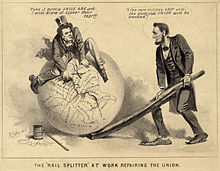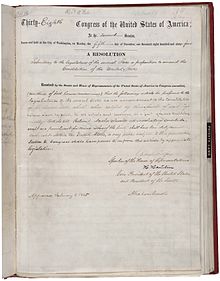Reconstruction Amendments
| This article is part of a series on the |
| Constitution of the United States |
|---|
 |
| Preamble and Articles |
|
Amendments to the Constitution |
|
Unratified Amendments : |
| History |
| Full text |


The Reconstruction Amendments, or the Civil War Amendments, are the
The Thirteenth Amendment (proposed in 1864 and ratified in 1865) abolished slavery and involuntary servitude, except for those duly convicted of a crime.[2] The Fourteenth Amendment (proposed in 1866 and ratified in 1868) addresses citizenship rights and equal protection of the laws for all persons. The Fifteenth Amendment (proposed in 1869 and ratified in 1870) prohibits discrimination in voting rights of citizens on the basis of "race, color, or previous condition of servitude."[3]
These amendments were intended to guarantee the freedom of the formerly enslaved and grant certain civil rights to them, and to protect the formerly enslaved and all citizens of the United States from discrimination. However, the promise of these amendments was eroded by state laws and federal court decisions throughout the late 19th century. The promise of these amendments was not fully realized until the Supreme Court decision in Brown v. Board of Education in 1954 and laws such as the Civil Rights Act of 1964 and the Voting Rights Act of 1965.
Background
The Reconstruction Amendments were adopted between 1865 and 1870,[1] the five years which immediately followed the Civil War.[4] The last time the Constitution had been amended was with the Twelfth Amendment more than 60 years earlier in 1804.
These three amendments were part of a large movement to reconstruct the United States that followed the Civil War. Their proponents believed that they would transform the United States from a country that was (in Abraham Lincoln's words) "half slave and half free"[5] to one in which the constitutionally guaranteed "blessings of liberty" would be extended to the entire populace, including the formerly enslaved and their descendants.
Thirteenth Amendment

The Thirteenth Amendment to the United States Constitution abolished
Slavery had been tacitly enshrined in the original Constitution through provisions such as Article I, Section 2, Clause 3, commonly known as the
Fourteenth Amendment
The Fourteenth Amendment to the United States Constitution was proposed by Congress on June 13, 1866.
The amendment's first section includes several clauses: the
The Due Process Clause prohibits state and local government officials from depriving persons of life, liberty, or property without legislative authorization. This clause has also been used by the federal judiciary to make most of the Bill of Rights applicable to the states, as well as to recognize substantive and procedural requirements that state laws must satisfy.[16]
The Equal Protection Clause requires each state to provide equal protection under the law to all people within its jurisdiction. This clause was the basis for the U.S. Supreme Court's ruling in Brown v. Board of Education (1954), that racial segregation in public schools was unconstitutional, and its prohibition of laws against interracial marriage, in its ruling in Loving v. Virginia (1967).[17][18]
Fifteenth Amendment

The Fifteenth Amendment to the United States Constitution prohibits the federal and state governments from denying a citizen the
In the some of the early United States, such as New Jersey prior to 1807, citizens of all races, regardless of prior enslavement, could vote provided that they could meet other requirements like property ownership.[19] But by 1869, voting rights were restricted in all states to white men. The narrow election of
Beginning around 1900, states in the former Confederacy passed new constitutions and other laws that incorporated methods to
In the twentieth century, the Court interpreted the amendment more broadly, striking down grandfather clauses in
Erosion, litigation, and scope
The promise of these amendments was eroded by state laws and federal court decisions throughout the late 19th century before being restored in the second half of the twentieth century. In 1876 and beyond, some states passed Jim Crow laws that limited the rights of African-Americans. Important Supreme Court decisions that undermined these amendments were the Slaughter-House Cases in 1873, which prevented rights guaranteed under the Fourteenth Amendment's privileges or immunities clause from being extended to rights under state law;[28] and Plessy v. Ferguson in 1896 which originated the phrase "separate but equal" and gave federal approval to Jim Crow laws.[29] The full benefits of the Thirteenth, Fourteenth, and Fifteenth amendments were not realized until the Supreme Court decision in Brown v. Board of Education in 1954 and laws such as the Civil Rights Act of 1964 and the Voting Rights Act of 1965.[30] The Reconstruction Amendments affected the constitutional division of power between U.S. state governments and the federal government of the United States, for the Reconstruction Amendments "were specifically designed as an expansion of federal power and an intrusion on state sovereignty."[31]
See also
- Crittenden Compromise
- Corwin Amendment
- National Freedom Day
- Reconstruction Acts
- Forty acres and a mule
- Ballot access in the United States
- Black suffrage in the United States
- Voting rights in the United States
- List of amendments to the United States Constitution
- Slavery Abolition Act 1833 (United Kingdom)
References
- ^ a b "U.S. Senate: Landmark Legislation: Thirteenth, Fourteenth, & Fifteenth Amendments". www.senate.gov. Archived from the original on December 30, 2020. Retrieved January 3, 2021.
- ^ "America's Historical Documents". National Archives. National Archives and Records Administration. January 25, 2016. Archived from the original on September 26, 2016. Retrieved November 25, 2018.
- ^ "The 15th Amendment of the U.S. Constitution". National Constitution Center – The 15th Amendment of the U.S. Constitution. Archived from the original on December 30, 2020. Retrieved January 3, 2020.
- ^ "(1865) Reconstruction Amendments, 1865-1870". BlackPast.org. January 21, 2007. Retrieved January 7, 2021.
- ^ Springfield, Mailing Address: 413 S. 8th Street; Us, IL 62701 Phone:492-4241 Contact. "House Divided Speech - Lincoln Home National Historic Site (U.S. National Park Service)". www.nps.gov. Retrieved March 25, 2021.
{{cite web}}: CS1 maint: numeric names: authors list (link) - ^ Greene, Jamal; McAward, Jennifer Mason. "The Thirteenth Amendment". Archived from the original on December 30, 2020. Retrieved August 21, 2020.
- ^ a b c d e "All Amendments to the United States Constitution". hrlibrary.umn.edu. Archived from the original on December 30, 2020. Retrieved August 21, 2020.
- ^ "The Constitution of the United States: Amendments 11-27". United States National Archives. Archived from the original on May 26, 2013. Retrieved February 24, 2014.
- ISBN 9780199660469.
- ^ "What The Emancipation Proclamation Didn't Do". NPR.org. Archived from the original on December 30, 2020. Retrieved December 30, 2020.
- ^ "A Century of Lawmaking for a New Nation: U.S. Congressional Documents and Debates, 1774 - 1875". memory.loc.gov. Archived from the original on December 30, 2020. Retrieved August 21, 2020.
- ^ Roe v. Wade, 410 U.S. 113 (1973).
- ^ Bush v. Gore, 531 U.S. 98 (2000).
- ^ "Committee at Odds on Reapportionment: Three Reports on the Bill Submitted to the House" (PDF). The New York Times. December 21, 1990. Archived (PDF) from the original on January 11, 2020. Retrieved November 25, 2018.
- ISBN 9780226845272. Archivedfrom the original on April 29, 2016. Retrieved October 31, 2015.
- ^ "BRIA 7 4 b The 14th Amendment and the "Second Bill of Rights"". www.crf-usa.org. Archived from the original on December 30, 2020. Retrieved December 30, 2020.
- ^ Brown v. Board of Education, 347 U.S. 483 (1954)
- ^ Loving v. Virginia, 388 U.S. 1 (1967)
- ^ "Did You Know: Women and African Americans Could Vote in NJ before the 15th and 19th Amendments?". National Park Service. Retrieved March 14, 2024.
- ^ "Passage of the Fifteenth Amendment | American Experience | PBS". www.pbs.org. Archived from the original on December 30, 2020. Retrieved December 30, 2020.
- ^ "Historical Voter Suppression – Notley Scholars Voter Rights Project". Archived from the original on December 30, 2020. Retrieved December 30, 2020.
- ISBN 978-0-8078-3324-7. Archivedfrom the original on December 30, 2020. Retrieved December 30, 2020.
- ^ a b Jervis, Rick. "Black Americans got the right to vote 150 years ago, but voter suppression still a problem". USA TODAY. Archived from the original on December 30, 2020. Retrieved December 30, 2020.
- OCLC 474353255.
- SSRN 224731. Archived from the original on December 30, 2020. Retrieved December 30, 2020.)
{{cite journal}}: Cite journal requires|journal=(help - ^ Guinn v. United States, 238 U.S. 347 (1915)
- ^ Harper v. Virginia Bd. of Elections, 383 U.S. 663 (1966)
- ^ Slaughter-House Cases, 83 U.S. 36.
- ^ Plessy v. Ferguson, 163 U.S. 537.
- ^ Brown v. Board of Education, 347 U.S. 483.
- ^ "City of Rome v. United States, 446 U.S. 156 (1980), at 179". Justia US Supreme Court Center. April 22, 1980. Archived from the original on March 4, 2024. Retrieved March 4, 2024.
External links
- The Reconstruction Amendments: Essential Documents (2 vols) (Kurt T. Lash, ed.) (University of Chicago Press, 2021)


